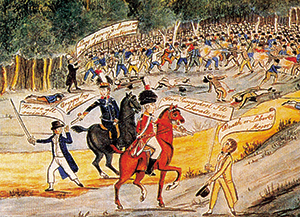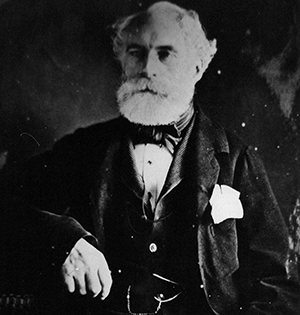ON THIS DAY
Published in Issue 2 (March/April 2019), News, Volume 27BY AODHÁN CREALEY
MARCH

04/1804
The Castle Hill (New South Wales) convict rebellion. Under cover of darkness, over 200 convicts (mainly Irish) escaped from Castle Hill government farm, some 30km west of Sydney town, intending to march there and ‘capture ships to sail to Ireland’. Their leader was Kerry-born United Irishman Philip Cunningham, a stonemason by trade, who had arrived in the colony four years earlier on the Anne, packed with transported fellow United Irishmen. In the course of that voyage he had taken part in a failed mutiny. As with rebel aspirations at home, things did not go according to plan. Though the escapees were reasonably well armed after raids on neighbouring homes, reinforcements from other convict stations failed to show up, forcing Cunningham to make camp and contemplate his next move. Meanwhile, he was elected ‘King of the Australian Empire’ by his followers, who designated the surrounding area as ‘New Ireland’. ‘New Ireland’, however, was short-lived. Having tracked them down, Major George Johnston, at the head of a contingent of redcoats, called on them to surrender and twice sent a priest to negotiate. But Cunningham stood firm, demanding ‘death or liberty, and a ship to take us home’. The subsequent battle, dubbed ‘the second Battle of Vinegar Hill’, was considerably less brutal than the first. Just one volley from Johnston’s men, which killed some fifteen rebels and wounded dozens of others, put the remainder to flight, and over the next few days c. 230 of them were arrested. While most were flogged, Cunningham and eight others were hanged and their bodies placed on gibbets. In 1982 a memorial marking the rebellion was placed in a nearby cemetery within Castlebrook Memorial Park.
03/1959
During the Mau Mau uprising against British colonial rule in Kenya, eleven insurgent detainees were clubbed to death in the Hola detention camp. A further 77 sustained serious injuries.
06/1939
Thomas Casement (76), Boer War and First World War veteran and brother of Sir Roger Casement, was found drowned at Baggot Street bridge, Dublin.
07/2009
Two British soldiers were shot dead by the Real IRA outside Massereene Barracks in Antrim town.
08/1869
Death of Hector Berlioz, French romantic composer, best known for his Symphonie Fantastique (1830), dedicated to Irish actress Harriet Smithson, whom he later married (1833).
11/2004
Groups inspired by al-Qaeda planted bombs on four morning rush-hour commuter trains in Madrid, killing 191 people and injuring 1,800.
18/1969
The newly inaugurated President Richard Nixon secretly authorised the use of long-range B-52 heavy bombers to carpet-bomb Cambodia. ‘Operation Menu’, as it was called, would continue until May 1970.
28/1969
Death of Dwight D. ‘Ike’ Eisenhower (78), American army general, supreme commander of the Allied Expeditionary Forces in Europe during the Second World War and 34th (Republican) president of the United States (1953–61).
28/1979
The worst-ever accident in the US nuclear power industry began when a pressure valve in a reactor at the Three Mile Island plant in Pennsylvania failed to close.
29/1869
Birth of Sir Edwin Lutyens, acclaimed British architect, whose works in Ireland include the Irish National War Memorial Gardens in Islandbridge, Dublin.
30/1969
An explosion destroyed an electricity substation in East Belfast, marking the beginning of a month-long series of attacks on electrical installations and water supplies by the UVF. At the time the IRA was blamed.
30/1979
Airey Neave (63), Conservative Party spokesman on Northern Ireland, was killed by a car bomb planted by the INLA in the House of Commons underground car park.
APRIL

04/1878
Murder of William Sydney Clements (72), 3rd earl of Leitrim. In 1854, after a career in the army in which he rose to the rank of lieutenant-colonel and a period in politics as MP for County Leitrim (1839–47), Clements inherited over 94,000 acres, including an estate of over 54,000 acres in Milford, north Donegal. He was a dreadful character. As the Freeman’s Journal reported, he was determined to destroy the Ulster custom/tenant right, describing Gladstone’s 1870 Land Act as ‘only another step in the process of spoliation which had been commenced by the Irish Church Act’ (disestablishment). His Donegal tenants, some 3,000 in number, bore the brunt of his belligerence. He prosecuted over 180 of them. A farmer who kept goats against his rules was forced to destroy them in his presence. Worse still, he was fond of having his way with his tenants’ daughters, one of whom subsequently drowned herself. Indeed, his notoriety was such that the lord lieutenant stripped him of his position as a justice of the peace. In the end it was his tenants who dispatched him. After a number of failed attempts, he was ambushed at dawn as he travelled from Manorvaughan to Milford. He met with a grizzly end. A volley of shots killed his driver and clerk instantly and seriously wounded the earl, who was finished off by blows to the head from a musket butt. Though enormous sums were offered as a reward for information, including £10,000 by the 4th earl, the cash was never collected. A cross commemorating his assassins—Ribbonman Michael McElwee and the Fenians Michael Hegarty and Neil Shields—was erected at the scene of the attack in 1960.
02/1989
The first Soviet–Irish summit. During a stopover in Shannon on his way to Cuba, Soviet leader Mikhail Gorbachev held an hour of talks with Taoiseach Charles J. Haughey and government ministers.
04/1949
The North Atlantic Treaty, an intergovernmental military alliance, was signed, bringing into being the North Atlantic Treaty Organization (NATO).
05/1869
Margaret Tennant, pioneer in public social work, who was chief adviser on women’s welfare in the Ministry of Munitions during the First World War, born in Rathgar, Dublin.
07/1719
Death of Jean-Baptiste de la Salle (67), French priest and Catholic saint (canonised in 1900) who founded the De La Salle schools.
13/1919
The Amritsar (Punjab) massacre. Up to 1,000 were killed and over 1,000 injured when troops of the British Indian Army, under the command of Col. Reginald Dyer, opened fire on local residents and travelling pilgrims. The event accelerated the rise of Indian nationalism.
17/1969
Bernadette Devlin (21, Unity candidate) won the Mid-Ulster Westminster by-election to become the youngest-ever MP in the House of Commons.
22/1969
Prime Minister Terence O’Neill agreed to universal suffrage—‘one man, one vote’—in local elections in Northern Ireland. His cousin, Major James Chichester Clarke, resigned in protest the following day.
25/1719
The life and strange adventures of Robinson Crusoe by Daniel Defoe was published.
25/1819
Vere Foster, philanthropist and educationist, born in Copenhagen, where his Irish-born father was British minister.
28/1969
Terence O’Neill resigned as Unionist leader and prime minister of Northern Ireland. He was succeeded by Major James Chichester Clarke, who defeated Brian Faulkner by one vote.
29/1769
Arthur Wellesley, 1st duke of Wellington (‘the Iron Duke’), soldier, politician and prime minister (1828–30), born at Mornington House, 24 Upper Merrion Street, Dublin, the fourth son of Garrett Wellesley, 1st earl of Mornington.
30/1919
Professor J.P. Mahaffy (80), scholar, provost of TCD since 1914, died.
















